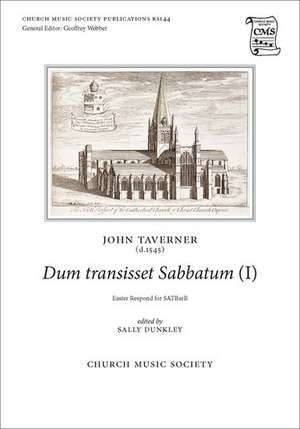Dum transisset Sabbatum (I): Church Music Society
Compozitor John Taverner Editat de Sally Dunkleyen Limba Engleză Sheet music – apr 2020
Din seria Church Music Society
-
 Preț: 28.36 lei
Preț: 28.36 lei -
 Preț: 28.36 lei
Preț: 28.36 lei -
 Preț: 32.48 lei
Preț: 32.48 lei -
 Preț: 31.61 lei
Preț: 31.61 lei -
 Preț: 32.48 lei
Preț: 32.48 lei -
 Preț: 32.48 lei
Preț: 32.48 lei -
 Preț: 35.14 lei
Preț: 35.14 lei -
 Preț: 32.48 lei
Preț: 32.48 lei -
 Preț: 32.48 lei
Preț: 32.48 lei -
 Preț: 32.48 lei
Preț: 32.48 lei -
 Preț: 35.14 lei
Preț: 35.14 lei -
 Preț: 35.14 lei
Preț: 35.14 lei -
 Preț: 32.48 lei
Preț: 32.48 lei -
 Preț: 36.13 lei
Preț: 36.13 lei -
 Preț: 32.48 lei
Preț: 32.48 lei -
 Preț: 32.48 lei
Preț: 32.48 lei -
 Preț: 36.13 lei
Preț: 36.13 lei -
 Preț: 46.46 lei
Preț: 46.46 lei -
 Preț: 28.36 lei
Preț: 28.36 lei -
 Preț: 26.18 lei
Preț: 26.18 lei -
 Preț: 26.06 lei
Preț: 26.06 lei -
 Preț: 32.48 lei
Preț: 32.48 lei -
 Preț: 36.13 lei
Preț: 36.13 lei -
 Preț: 22.67 lei
Preț: 22.67 lei
Preț: 32.48 lei
Nou
Puncte Express: 49
Preț estimativ în valută:
6.22€ • 6.44$ • 5.19£
6.22€ • 6.44$ • 5.19£
Disponibil
Livrare economică 18-24 februarie
Preluare comenzi: 021 569.72.76
Specificații
ISBN-13: 9780193954205
ISBN-10: 0193954206
Pagini: 12
Dimensiuni: 180 x 260 x 2 mm
Greutate: 0.03 kg
Ediția:Vocal score
Editura: OUP OXFORD
Colecția OUP Oxford
Seria Church Music Society
Locul publicării:OXFORD, United Kingdom
ISBN-10: 0193954206
Pagini: 12
Dimensiuni: 180 x 260 x 2 mm
Greutate: 0.03 kg
Ediția:Vocal score
Editura: OUP OXFORD
Colecția OUP Oxford
Seria Church Music Society
Locul publicării:OXFORD, United Kingdom
Notă biografică
John Taverner (c.1490-1545) was one of the leading Tudor composers of the late medieval style. Despite his prominence, the details of his life before 1524 are unknown, though in this year he served as a lay clerk at the collegiate church in Tattershall, Lincolnshire. Soon after, Taverner sang for the nearby Church of St Botolph in Boston, before holding the post of Organist and Master of the Choristers at Cardinal College, Oxford (later Christ Church) from 1526 until 1530. He then returned to Boston but his later life is mostly unknown. Taverner was admonished in 1528 for activity associated with the Lutherans, though escaped punishment for being 'but a musician'. The majority of his surviving musical output dates from the 1520s, and mostly comprises sacred motets, masses (notably the Western Wynd Mass) and other liturgical settings. Unlike his predecessors, Taverner's music began to display continental influence through his adoption of a smoother and less ornate contrapuntal style.
